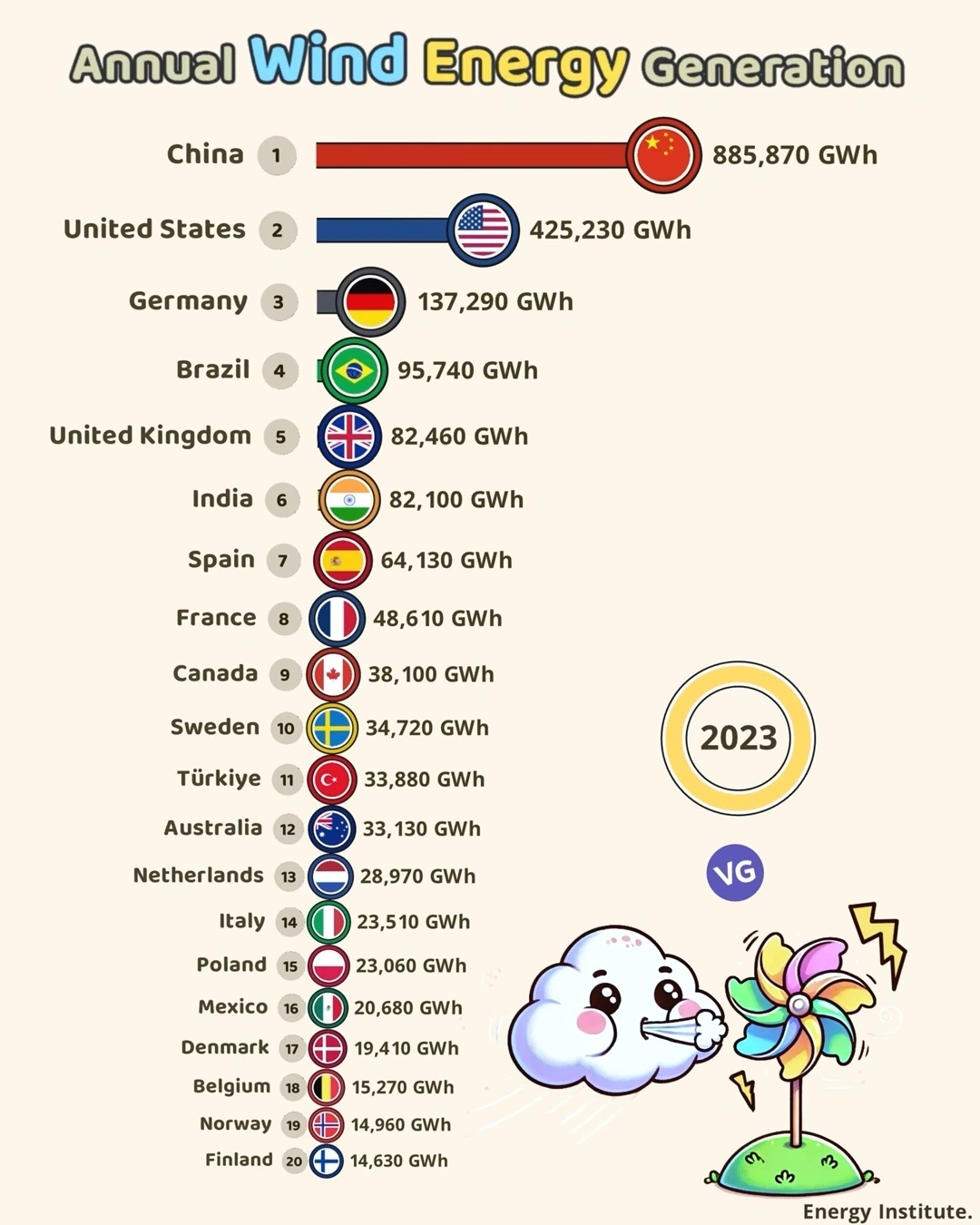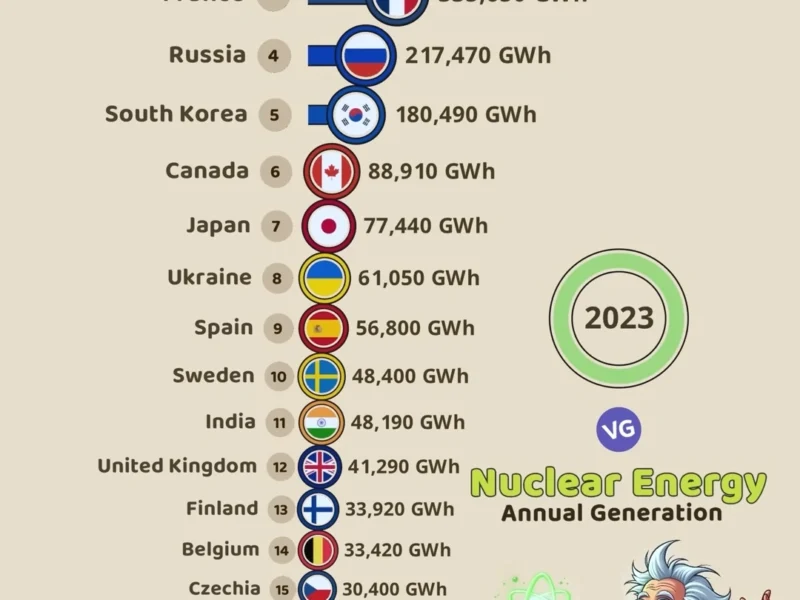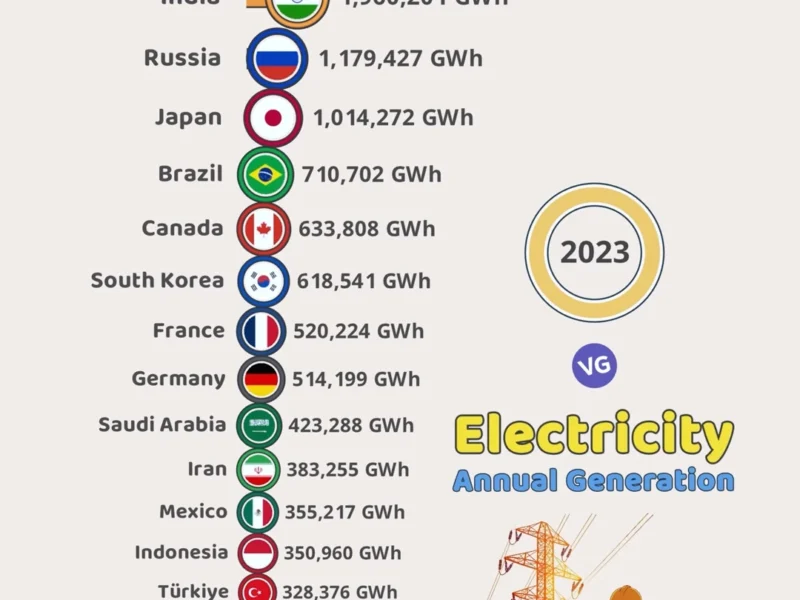Wind energy is emerging as a crucial solution to global energy challenges, reducing dependence on fossil fuels. In 2023, several countries solidified their positions as world leaders in wind energy production, highlighting an accelerated transition toward renewable sources.
Top Wind Energy Generating Countries (2023)
| Rank | Country | Wind Energy Generation (GWh) |
|---|---|---|
| 1 | 🇨🇳 China | 885,870 |
| 2 | 🇺🇸 United States | 425,230 |
| 3 | 🇩🇪 Germany | 137,290 |
| 4 | 🇧🇷 Brazil | 95,740 |
| 5 | 🇬🇧 United Kingdom | 82,460 |
| 6 | 🇮🇳 India | 82,100 |
| 7 | 🇪🇸 Spain | 64,130 |
| 8 | 🇫🇷 France | 48,610 |
| 9 | 🇨🇦 Canada | 38,100 |
| 10 | 🇸🇪 Sweden | 34,720 |
| 11 | 🇹🇷 Türkiye | 33,880 |
| 12 | 🇦🇺 Australia | 33,130 |
| 13 | 🇳🇱 Netherlands | 28,970 |
| 14 | 🇮🇹 Italy | 23,510 |
| 15 | 🇵🇱 Poland | 23,060 |
| 16 | 🇲🇽 Mexico | 20,680 |
| 17 | 🇩🇰 Denmark | 19,410 |
| 18 | 🇧🇪 Belgium | 15,270 |
| 19 | 🇳🇴 Norway | 14,960 |
| 20 | 🇫🇮 Finland | 14,630 |
Ranking of the Largest Wind Energy Producers
According to the Energy Institute, China overwhelmingly leads global wind energy production, generating 885,870 GWh in 2023. This figure is more than double that of the United States, which ranks second with 425,230 GWh. Despite its smaller size, Europe has several major players, including Germany (137,290 GWh), the United Kingdom (82,460 GWh), and Spain (64,130 GWh).
In South America, Brazil stands out with 95,740 GWh, demonstrating the country’s growing wind energy potential. India, meanwhile, continues to strengthen its infrastructure with 82,100 GWh, securing its position as a leader in Asia after China.
Why Does China Dominate?
China has heavily invested in wind power over the past decades. Its success is based on several factors:
- Strong government support: The Chinese government has implemented incentives, including subsidies and quotas, to encourage renewable energy development.
- Massive industrial production: China is the world’s largest wind turbine manufacturer, which lowers installation costs and accelerates deployment.
- Abundant natural resources: Vast plains and windy coastlines provide ideal conditions for wind energy.
Europe: A Key Player Despite Its Smaller Size
The European Union has been a pioneer in adopting renewable energy. Germany, in particular, has long been a model thanks to its Energiewende policy. While some European countries, like France (48,610 GWh), have lagged, the energy transition remains a priority across the continent.
The United Kingdom also stands out with its offshore wind farms. Offshore wind power is particularly profitable as it benefits from stronger and more consistent winds.
The Future of Wind Energy
According to the International Energy Agency (IEA), wind energy will continue to grow rapidly. Several trends are emerging:
- Development of new technologies: Wind turbines are becoming larger and more efficient, with rotor diameters exceeding 200 meters.
- Increased investments: Companies like Vestas and Siemens Gamesa are heavily investing in research and development.
- Expansion in Africa and Latin America: Countries like South Africa (15,570 GWh) and Mexico (20,680 GWh) are showing increasing interest in wind power.
Conclusion
Wind energy plays a crucial role in the global energy transition. While China and the United States currently dominate, other regions are investing significantly to reduce their carbon footprint. The future looks promising for this clean energy source, which is expected to continue gaining ground over fossil fuels.



